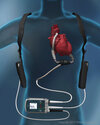Can an artificial heart run out of power?
Cardiovascular surgery(09.12.2016) Almost two million people in Germany suffer from heart failure, where the heart is no longer able to pump enough blood through the body on its own. Conventional therapies such as special medication can strengthen the heart again. If these treatment methods do not help, there is a possibility that so-called terminal heart failure will develop. The heart is then so weakened that its pumping capacity is no longer sufficient to keep the body alive. For some patients, a battery-powered ventricular assist device (commonly known as an "artificial heart") is then a lifesaver.
But what happens when the batteries run out, as happened recently to a man near Freiburg? Prof. Dr. Friedhelm Beyersdorf, Medical Director of the Department of Cardiovascular Surgery at the University Heart Center Freiburg ∙ Bad Krozingen, answers three questions on this topic.
Why can the batteries in an artificial heart run out?
"The ventricular assist device, often referred to as an artificial heart, consists of a pump implanted in the body (centrifugal or axial pump), which is inserted between the apex of the heart and the aorta. A small cable, which is routed from the patient's abdomen, connects the artificial heart to the control unit and batteries located on the outside of the body. The pump must be constantly supplied with power so that it can support the patient's diseased heart. The batteries are rechargeable batteries. When they are empty, they have to be replaced and recharged. Whereas previously the batteries could only operate the pump for six hours, they now last for almost 16 to 18 hours."
What happens when the artificial heart's batteries run out?
"That can't really happen because the system is doubly backed up. The pump is always supplied with power by two batteries at the same time. The patient should therefore always carry two fully charged spare batteries with them. A signal tone alerts the artificial heart patient that the batteries in the device will soon be empty and must be replaced. In the unusual case that the patient has discharged batteries or no batteries at all, the pump will stop working. The artificial heart patient should then go home as quickly as possible to insert new batteries. In this case, it is important that they do not drive home themselves, but get help. The best thing to do is to call the emergency hotline of the clinic where the ventricular assist device was implanted. From there, the quickest way to organize transport home to the fully charged batteries is through the police, for example."
What does the future hold? Will batteries be superfluous at some point?
"As part of a research project, the University Heart Center Freiburg ∙ Bad Krozingen has specialized in working on improvements to these support systems and developing them further. Our aim is to eventually be able to charge the batteries by induction and not have to lead a cable out of the body. Carrying the batteries in a shoulder bag restricts patients in their everyday lives; for example, they can only shower carefully and can no longer bathe. Nevertheless, with today's ventricular assist device, they are much more mobile than before. A donor heart is still the only permanent solution for patients, so it is important that many people register as organ donors."
The artificial heart is connected to the diseased heart in a surgical procedure. The patient's own heart is not replaced, but supported by a mechanical pump. The battery-operated pump delivers the full performance of a healthy heart and can pump eight to ten liters of blood per minute.
Sign up for our newsletter and receive the latest news from our online magazine "In Focus"


